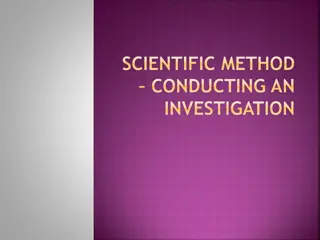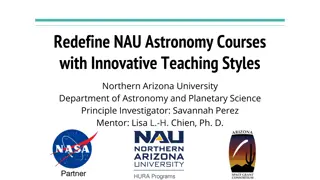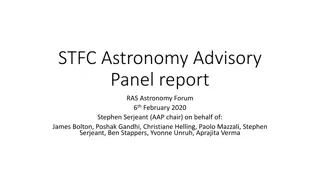Introduction to Astronomy: Exploring the Universe and Scientific Method
Distant galaxies, the oldest science of astronomy, and the scientific method are explored in this content. Astronomy delves into the study of objects beyond Earth, while the scientific method serves as a tool to understand nature through observations and experiments.
Download Presentation

Please find below an Image/Link to download the presentation.
The content on the website is provided AS IS for your information and personal use only. It may not be sold, licensed, or shared on other websites without obtaining consent from the author.If you encounter any issues during the download, it is possible that the publisher has removed the file from their server.
You are allowed to download the files provided on this website for personal or commercial use, subject to the condition that they are used lawfully. All files are the property of their respective owners.
The content on the website is provided AS IS for your information and personal use only. It may not be sold, licensed, or shared on other websites without obtaining consent from the author.
E N D
Presentation Transcript
Astronomy 1010 chapter 1 Clayton State University Slides for Astronomy textbook from OpenStax https://openstax.org/books/astronomy/
Distant interacting islands of stars (galaxies) are so far away that their light takes hundreds of millions of years to reach us on Earth (photographed with the Hubble Space Telescope). (credit: modification of work by NASA, ESA, the Hubble Heritage ESA/Hubble Collaboration, and K. Noll (STScl)) Galaxies. These two (STScl/AURA)- What is Astronomy? It is the oldest science in the world Astronomy is defined as the study of the objects that lie beyond our planet Earth and the processes by which these objects interact with one another. It is also humanity s attempt to organize what we learn into a clear history of the universe, from the instant of its birth in the Big Bang to the present moment. 2
Science is What is science? Around the circle: What do you think science is? What do scientists do? How is it different from philosophy and believes? 3
Scientific method explained The ultimate judge in science is always what nature itself reveals based on observations, experiments, models, and testing. Science is not merely a body of knowledge, but a method by which we attempt to understand nature and how it behaves. This method begins with many observations over a period of time. From the trends found through observations/experiments, scientists can model the particular phenomena we want to understand. Such models are always approximations of nature, subject to further testing. When they are first proposed, new models or ideas are sometimes called hypotheses. 4
Scientific method explained 2 A hypothesis must be a proposed explanation that can be tested. That is, it must both explain the existing data and make predictions as well! The most straightforward approach to such testing in science is to perform an experiment. If the experiment is conducted properly, its results either will agree with the predictions of the hypothesis or they will contradict it. If the experimental result is truly inconsistent with the hypothesis, a scientist must discard the hypothesis and try to develop an alternative. If the experimental result agrees with predictions, this does not necessarily prove that the hypothesis is correct; perhaps later experiments will contradict crucial parts of the hypothesis. But the more experiments that agree with the hypothesis, the more likely we are to accept the hypothesis as a useful description of nature. Experiments can be done by anyone and anywhere given the proper procedure! 5
Scientific notation refresher Astronomy uses very large numbers Scientific notation is most useful to right them down 2.5 x 1012 means to take 2.5, move the decimal 12 places to the right and fill in the open gaps with zeros to make 2,500,000,000,000 or 2.5 trillion. In scientific notation, the number on the left is always a single digit followed by a decimal point and the correct (see significant figures) number of digits after the decimal. -3.2 x 10-5 means to take the negative number -3.2, and move the decimal 5 places to the left, filling in the open gaps with zeros to make - 0.000032. Notice that the minus sign to the left of the 3.2 has nothing to do with the exponent, and simply indicates a negative number. Mass of the Sun is 2 1030 kg (note that x is typically omitted) 7
SI units, CGS units 1 m3 of water weighs about 1 ton or 1000 kg. 1000 cm3 of water is 1 liter or 1 kg. Astronomy often uses CGS system: centimeter, gram, second. Derived units will change accordingly In this class, only SI Three temperature scales are in general use: Fahrenheit (F); water freezes at 32 F and boils at 212 F. Celsius (C); water freezes at 0 C and boils at 100 C. Kelvin (or absolute) (K); water freezes at 273 K and boils at 373 K. All molecular motion ceases at about 459 F = 273 C = 0 K, a temperature called absolute zero. The full conversion formulas are: K = C + 273 C = (5/9) ( F 32) F = (9/5) C + 32 8
Scale of Astronomy Parallax definition of stellar distances Astronomical Constants astronomical unit (AU) 1.496 1011m Light-year (ly) 9.461 1015 m parsec (pc) 3.086 1016 m = 3.262 light-years sidereal year (y) 3.156 107 s mass of Earth (MEarth) 5.974 1024 kg equatorial radius of Earth (REarth) 6.378 106 m https://hubblesite.org/image/3 148/category/12-cosmology 9 https://sites.google.com/site/chem physchanges/astronomical-unit
Getting Familiar with a Light-Year How many kilometers are there in a light-year? Solution Light travels 3 105km in 1 s. So, let s calculate how far it goes in a year: There are 60s in 1 min, and 60 min in 1 h. Multiply these together and you find that there are 3.6 103s/h. Thus, light covers 3 105km/s 3.6 103s/h = 1.08 109km/h. There are 24 h in a day, and 365.25 (3.65 102) days in 1 y. The product of these two numbers is 8.77 103h/y. Multiplying this by 1.08 109km/h gives 9.46 1012km/light-year. That s almost 10,000,000,000,000 km that light covers in a year. To help you imagine how long this distance is, we ll mention that a string 1 light-year long could fit around the circumference of Earth 236 million times. 10























